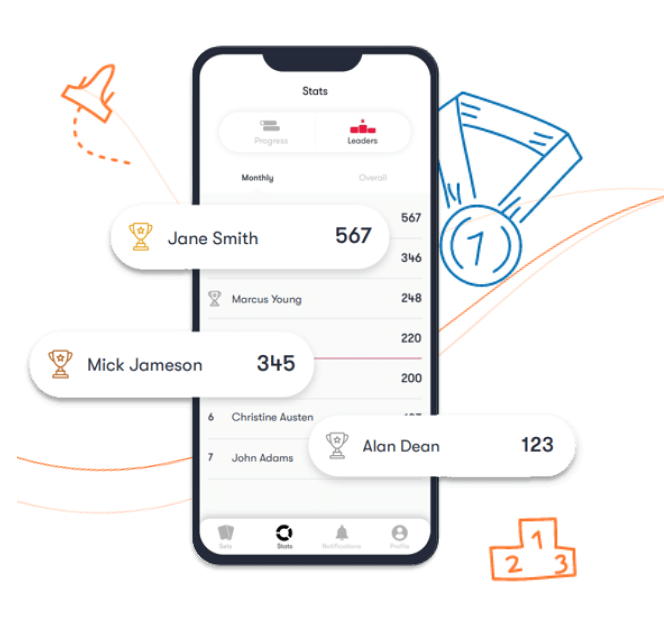In an effort to combat employee turnover as well as attract new talent, many companies are offering higher pay, flexible working hours, better benefits, more paid time off, and more training opportunities. But what about spot bonuses?
The reality is that while companies may promise large annual bonuses to their employees if the organization as a whole hits its targets, these targets aren’t always reached. And in some cases, this isn’t through the fault of the employees.
A failure to hit overall targets doesn’t mean that the company’s hands are tied. You can still find a way to reward those employees that go above and beyond. One such way is through the use of spot bonuses.
- What is a spot bonus?
- Why should you give an employee a spot bonus?
- What is the difference between a spot bonus and a retention bonus?
- Examples of spot bonuses and rewards
- Examples of how employees can earn spot bonuses
- Linking spot bonuses with training goals
- Benefits of awarding spot bonuses
- Tips on how to implement a spot bonus program
- FAQs
- Key takeaways
What is a spot bonus?
A spot bonus is a reward paid on the spot for a positive behavior, action, or result. Recognition can come in monetary or non-monetary forms. Unlike regular bonuses, spot bonuses are a spontaneous gesture of appreciation for outstanding efforts.
Why should you give an employee a spot bonus?
Spot bonuses give you the chance to recognize outstanding employee performance in a way that goes beyond the expected rewards and compensation that have already been agreed upon. Because spot bonuses are unexpected they are a tool that you can use to motivate, engage, and retain your employees.
Here’s why you should consider giving your employees spot bonuses:
Recognition of outstanding performance
Spot bonuses provide tangible recognition for employees who consistently go above and beyond their regular duties. This fosters a sense of appreciation and value.
Motivation and morale boost
By rewarding exceptional performance, spot bonuses motivate employees to maintain high levels of productivity and dedication. This, in turn, boosts morale. It’s true in any company that your top performers don’t just do their jobs well— they help others do their jobs well too. Keeping these people motivated is key.
Retention and loyalty
This goes hand in hand with motivation. Recognizing employees’ efforts through spot bonuses makes them feel valued and appreciated, increasing their commitment to the organization. And as the labor market gets more competitive, retention remains critical.
Improved performance and productivity
Spot bonuses incentivize employees to continue delivering exceptional results, leading to improved performance, increased productivity, and higher-quality work. Beyond motivating the recipient, they also motivate the recipient’s peers. By seeing a tangible example of what type of behavior gets rewarded, employees know what they should be striving for.
Gain a competitive advantage in attracting top talent
Offering spot bonuses as part of your rewards package can attract top talent. It shows your organization’s commitment to recognizing and rewarding exceptional performance. You don’t even have to outline a specific amount or goal (because then this wouldn’t be a spot bonus) in the initial new hire agreement. Simply being a company that knows what a spot bonus is, and using them, surely makes you stand out from the rest.
What is the difference between a spot bonus and a retention bonus?
While spot bonuses reward exceptional performance, retention bonuses are given as an incentive to stay with the company for a period of time. Spot bonuses can be given anytime, whereas retention bonuses are often given at the end of the year, or when an employee completes a certain number of years with the company. Also note that retention bonuses are not based on performance, while spot bonuses are entirely performance based.
Examples of spot bonuses and rewards
Spot bonuses can range from $50 to over $5,000. These incentives offer around 1% of a company’s payroll to 25% of eligible employees. Keep in mind that spot bonuses are not meant to reward all employees. They serve to highlight those who are leading by example.
You also don’t need to use up the funds you’ve set aside for this initiative if you haven’t seen results. This program should be results orientated and not an obligation.
What is an example of a spot reward?
While spot bonuses and rewards usually come in the form of money, they can also be non-monetary, such as:
- Trips and weekend getaways
- Extra paid time off
- Gift cards
- Gifts
Examples of how employees can earn spot bonuses
Outstanding Customer Service: An employee who consistently receives positive feedback from customers and demonstrates exceptional customer service skills could be awarded a spot bonus as a token of appreciation.
Innovative Problem Solving: Recognizing an employee who comes up with innovative solutions to complex problems and contributes to process improvements with a spot bonus.
Exceeding Performance Goals: A sales representative who surpasses sales targets and generates significant revenue for the company may receive a spot bonus as a reward for their outstanding performance.
Linking spot bonuses with training goals
In addition to rewarding exceptional performance, you can also award spot bonuses to employees who are consistently engaging with their training and show a dedication to improving their skills and knowledge. One common method is for companies to use a training platform with gamification features.
For example, when delivering training to employees using TalentCards, you’ll give them the opportunity to compete for points and rank on the app’s leaderboard. Learners earn points for successfully completing courses and passing quizzes, and can even earn extra points for being among the first in their team to do so, and for logging in and engaging with their training on a regular basis.
At the end of the month you can view which employees are at the top of the leaderboard, and award these team members with gift cards or other small rewards to acknowledge their commitment to training, as well as foster healthy competition among team members.
Link spot bonuses to employee training with TalentCards

Benefits of awarding spot bonuses
Spot bonuses offer many benefits not just to employees, but to the overall company:
- Increased motivation and engagement
- Improved morale and job satisfaction
- Enhanced productivity and performance
- Strengthened retention and loyalty
- Foster a culture of excellence
- Competitive advantage in attracting top talent
Annual bonuses have become an expectation in many organizations. With spot bonuses, there is more spontaneity and the timing can be used to your advantage. Awarding them mid-year when an annual bonus is far away can be helpful.
Tips on how to implement a spot bonus program
To effectively implement a spot bonus program, consider the following dos and don’ts:
Do —
- Tie spot bonuses to measurable achievements and training goals
- Provide clear criteria for earning spot bonuses
- Foster a culture of recognition and appreciation
- Celebrate diversity and recognize contributions from different job roles
- Maintain open communication about the spot bonus program
Don’t —
- Play favorites or show favoritism
- Use spot bonuses as a substitute for fair compensation practices
- Overlook collaborative efforts and team achievements
- Limit spot bonuses to top performers only
- Neglect feedback and improvement opportunities.
Come up with a plan that works well for everyone and prioritize gaining insights from those who work directly with your staff so that the rewards are meaningful.
FAQs
What is another name for a spot bonus?
A spot bonus might also be called an on-the-spot incentive, spot reward, spot bonus incentive, or a spot award. Each has the same meaning.
How is a spot bonus calculated?
Keeping the total amount you reward to around 1% of your company’s payroll will ensure that this remains a low-cost initiative. It is up to you how you want to disperse this sum.
How much should I ask for a spot bonus?
A spot bonus is usually equal to less than 1% of your salary. Before asking for one, try to determine if your organization has a program in place. If they do, find out what they look for when awarding these bonuses.
How do I decide who to give a spot bonus to?
You might feel the desire to get everyone in on this program. But, you need to remember who will benefit from this the most. This is not for your higher-ranking staff. Provide it for those who will appreciate the impact of an extra $50 – $500, not those who already earn six figures.
Spot bonuses are an easy way to positively impact your employees
Having a spot bonus program should enhance positive feelings for both the company and the employee receiving it.
Remember, don’t award in private! Hand it to them so others can see, not only to motivate everyone to strive for excellence, but to ensure transparency and not create any negative feelings of bias or favoritism.
Let your employees know you appreciate them. Celebrate those wins together.
By implementing spot bonuses effectively, your organization can create a positive impact on employee satisfaction, engagement, and overall performance, ultimately contributing to their success.
Key takeaways
- Spot bonuses are a powerful tool for recognizing and rewarding exceptional performance among employees. They go beyond regular bonuses and provide your team members with a spontaneous gesture of appreciation.
- Spot bonuses differ from retention bonuses. While spot bonuses reward exceptional achievements, retention bonuses focus on employee tenure and loyalty, typically given once a year.
- Examples of spot bonuses can range from monetary rewards to non-monetary incentives like trips, extra paid time off, or gifts. It’s important to align the reward with the employee’s preferences and unique contributions.
- Implementing a spot bonus program requires clear criteria for earning spot bonuses, a culture of recognition and appreciation, and open communication.
- Spot bonuses should be used strategically and not as an obligation. They can be awarded mid-year, providing a sense of spontaneity and timing that distinguishes them from annual bonuses.


